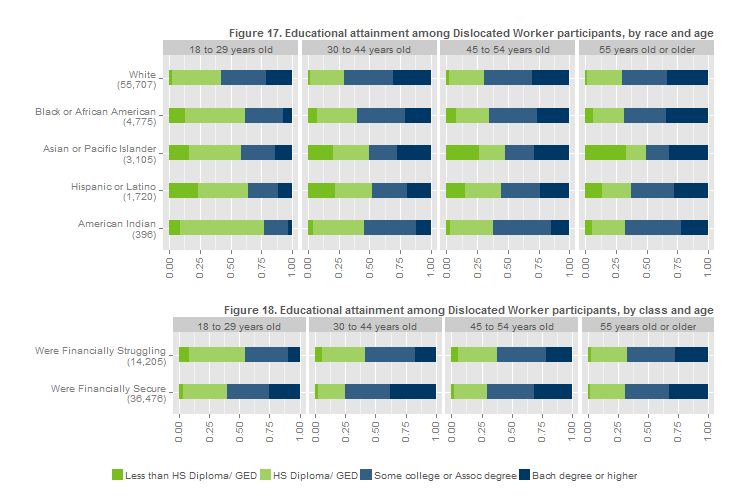Figures 17 through 20 show the education attainment that Dislocated Worker and Adult program participants had at the time of enrollment. Because individuals can attain higher education throughout their working life, we show results by age cohort.

A striking feature of the figures showing educational attainment by race is the high rates of 'Less than HS Diploma/GED' among Asian or Pacific Islander and Hispanic or Latino participants, especially among older cohorts (Figures 17 and 19). Given the information presented in the section 'Limited English skills', this may be driven by participants in immigrant communities who grew up in a different education system. DEED programs are beginning to collect information on immigration status, so an analysis on this topic will be possible in the future.
Otherwise, white participants and participants who were financially secure prior to participation tend to have the highest postsecondary educational attainment rates, especially among cohorts under age 45. This could indicate multiple different trends. Perhaps white participants and financially secure participants have a head start in postsecondary educational attainment. Although this would imply that the other groups catch up towards middle age, those who are highly educated at younger ages have a longer period of earning the rewards associated with higher education.
Because this is a snapshot in time, these figures could also reflect the changing higher education context of increased tuition costs, or it could simply reflect differences in who is likely to participate in the program.

Whatever the underlying cause, the educational attainment of program participants has direct relevance in the job market. In the job search process, a college degree can serve as an applicant screening tool even when a degree is not required for the job, a policy that would disproportionately rule out younger participants of color and lower income participants in these programs (See Note 1).
One program manager spoke to this use of education as a screening tool. When asked about the role employers can play in addressing disparities, La Tasha Shevlin, Director of Adult Employment and Training at East Side Neighborhood Services, said:
"I believe a lot of the racial disparities come from a classism too, [...] and education is a class: [it] definitely sets people apart when it comes to class. [...]It leads to a lot of [...] unconscious racism, essentially. Minnesota is a state that very much values education. So if you have people like the individuals that we work with here at East Side Neighborhood Services who have a lower education level, that is shutting them out of employment. And it's a domino effect, essentially, going back from the achievement gap. [...] I think a lot of places are open to diversity, [as long as] it comes to them in a package they like, which includes highly educated."
Additionally, our interviews with program managers indicated that those with no experience with higher education often have a mental barrier to seeing themselves enroll in school. When asked about barriers to long-term training, Bev Warren, Rural Minnesota CEP Team Leader at the Bemidji WorkForce Center, said,
"Some of our clients that we bring there [to Northwest Technical College, as a part of graduating the Beltrami Works leadership program] never envisioned ever walking through those doors. And so by virtue sometimes of us bringing them there, we've had clients say 'You know what, I think I can do this. I think I can be here.'"
See Training Engagement Rates for information on training rates through these programs, which have the potential to reduce some of the educational attainment gaps we see at enrollment.